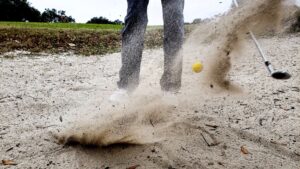 Golf clubs and courses have a reputation of being idyllic and tranquil settings, oftentimes with views and landscapes that draw not only new members, but individuals looking to host special events like weddings with a beautiful backdrop and readily available hospitality services.
Golf clubs and courses have a reputation of being idyllic and tranquil settings, oftentimes with views and landscapes that draw not only new members, but individuals looking to host special events like weddings with a beautiful backdrop and readily available hospitality services.
As more and more courses are developed in these highly coveted areas, residential properties and condo associations are capitalizing on the same attraction by including new construction communities abutting this land. Many a golfer dreams to retire to a place where their favorite hole (watering or otherwise) is just a short golf cart ride away, but many families who have purchased high value homes in these seemingly quiet neighborhoods have experienced a rude awakening.
Just last year a family living near a Massachusetts course settled for $5 million after their brand new home was repeatedly struck by errant golf balls. Large settlements like this and other lawsuits seeking restitution for physical, emotional, and mental damages have piqued the interest of club owners, residents along the course, and golfers themselves with the big question being “Who’s at fault?”
The simple answer to this question is, “it depends.” Various factors are considered by the judge when determining the guilty party in any incident, including:
⛳ Did the course have proper netting in place in common landing areas?
⛳ Did the homeowner understand the risk of their location before purchasing their home?
⛳ Was the golfer intentionally being negligent of resident property?
Risk mitigation for all parties in this type of scenario can help avoid these conflicts all together. It’s important for golfers, homeowners, and course management to have a clear understanding of their coverages in regards to the varying liabilities that surface depending on each unique situation.

GOLFER CONSIDERATIONS
Part of the challenge and beauty of the sport of golf is that it is intended for all skill levels and balls do not always go where intended. As a golfer, you are responsible for playing in a reasonable manner and following the rules outlined by your club, as well as taking into consideration common courtesy when playing near residential areas. While some courses offer opportunities for work-around shots to cut specifically challenging angles, it’s important to use common sense and not intentionally direct shots that have a good chance of hitting neighboring property, including homes, cars, or open yard areas.
In the event your ball has a mind of its own, remember the following:
- If you hear breaking glass or see damage occur, notify the homeowner out of courtesy
- Notify your club manager of the damage when you return to the clubhouse
- Review your club rules and regulations pertaining to liability and next steps
HOMEOWNER CONCERNS
While homeowners take on a reasonable expectation of risk by purchasing property near a golf course, oftentimes community guidelines or condo association documents have very specific language outlining how claims like these should be handled.
Things for a homeowner to consider:
- Is your current situation addressed clearly in your homeowners insurance or condo association documents?
- Did the issues begin occurring after changes were made to the golf course after your home was built/purchased?
- Have you spoken with course management about your concerns or potential improvements to help prevent further issues?
COURSE RESPONSIBILITIES
Homeowners may assume some of the risk associated with purchasing property near a golf course, but course owners still need to do their part to protect their neighbors. Adding netting, shrubs, and fencing to high traffic areas can aid both parties in protecting themselves. Also, in the event of a particularly challenging landscape, course managers have the opportunity to change the layout of a hole to influence the direction of high impact shots away from nearby homes.
Another important element for courses set in residential areas is member education. Ensure that your golfers are instructed on proper course etiquette and where it is appropriate to hit the ball, where it is prohibited, and what to do if an issue arises on the course. Having a member relations employee available for questions who is well versed in the club rules and any corresponding condo association guidelines can be a vital first point of contact in navigating these types of concerns.
HOW ROGERSGRAY CAN HELP
As the official Risk Management Partner of Mass Golf, RogersGray is uniquely equipped to help member clubs identify potential coverage gaps and areas of increased liability in the areas of errant golf balls and more.
Reach out to our team today to discuss our RiskMap and Risk Mitigation Services to determine if our curated programs could be a viable solution for you and your club.
Jack Snow
Associate Advisor
 Jack Snow is an Associate Advisor with RogersGray.
Jack Snow is an Associate Advisor with RogersGray.
